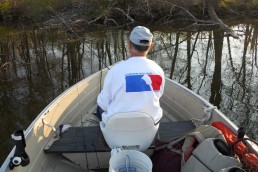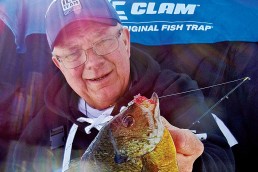Follow the Melting Ice to Shallow-water Bluegill Bites
SHARE THIS POST
It was a warm day in March—and boy did it feel good. It had been a long, hard winter and we were wondering if the ice would ever leave the lakes. Finally, some open water appeared. A fish buddy—who like me was going stir-crazy—called.
“Hey, there’s some open water on Mogadore Reservoir,” he said. “Let’s go out and try to catch some bluegills or anything else that bites. I gotta catch some fish from a boat.”
As I pushed the jon boat off, water went into one of my farm boots. Wow, was it cold. We hit some of our favorite spots, but to no avail. Later in the afternoon, a southerly breeze slowly blew our boat into a sunlit bay. As we approached a shallow mucky shoreline, we spooked some bluegills. The water was only a couple feet deep.
Quickly anchoring, we cast out our baits. As soon as the bobbers hit the water, the fish disappeared. I reached into my panfish tackle box and took out one of my larger ice fishing bobbers. To the 4-pound-test line, I tied a size 10 Aberdeen hook. Baiting it with a couple maggots, I tossed it past the school of fish. I worked it toward the bluegills with a slow stop-and-go retrieve. The float gently jiggled and slowly swam sideways; I set the hook into a nice 8-inch bluegill.
My partner switched over to the subtle rig; he too caught a nice ‘gill. After catching a couple dozen, the sun disappeared and so did the fish. We left the lake to fillet our season’s-first bluegills. It was the earliest we had ever caught bluegills from a boat.
Over the years, we learned that this early-season action is found in many lakes and reservoirs as soon as the ice leaves. In fact, there have been times when we fished a reservoir when the main lake was still frozen.
As in all fishing, location is critical. Often the shallow end of the reservoir, where the feeder creek enters, is a good starting point. The water from this tributary warms and adds oxygen to the lake. This attracts small baitfish and the heated water also activates insect larvae and zooplankton. These baits attract plenty of bluegills.
However, all shallow bays aren’t equal. Those with mucky bottoms, receiving sunlight are prime spots. The solar rays turn into heat when hitting the black goo. This attracts the cold-blooded bluegills. Some of the best super-early spots are in shallow depths that quickly become weed-choked. Here, big ‘gills can be caught in water depths less than 1 foot, and sometimes their backs are out of the water.
Don’t ignore submerged wood here. Timber also heats up when sunbeams strike the dark-colored wood. At times, a bucketful of big bluegills can be taken from a single sunken tree.
Other spots that contain early season bluegills would be bays on the northwest shores. Now, the sun is positioned more toward the southerly sky. On a sunny afternoon, the water temperature in these northerly bays can rise 4 to 5 degrees.
Are you enjoying this post?
You can be among the first to get the latest info on where to go, what to use and how to use it!
Once again, muck, wood and dead weeds attract bluegills. And, dead plants attract these fish and the insects. It isn’t toxic because over the winter currents and spring rains have cleansed it.
However, “here today, gone tomorrow” often characterizes these ice-out sunfish. When it is sunny, bluegills will follow a channel edge from deeper water to the mucky shallows. During a cold front though, the ‘gills skedaddle out of there. Then they can be found in submerged timber or at the first break in deeper water.
Cruise slowly at the breakline with your locator on. Often, these ‘gills are visible because they suspend a few feet off the bottom. Vertically work small ice spoons tipped with maggots over them. Surprisingly, artificial baits also work at times. Try a Northland Blood Worm on a 1/16-ounce jig. Barely lift and twitch it above the ‘gills. When done correctly, its pulsating body induces a strike. Adding a maggot to the jig/bloodworm’s hook can entice a super finicky fish to hit.
One other spot easy to see in early spring is a bank with cattails. The prime cattails are on the sunny north shores. These tall plants like the muck and give shelter to insects and minnows. They also provide vertical cover for sunfish.
In thin waters, shallow-water dwellers can be mighty spooky. This is especially true in clear water. Downsize your equipment. Four- or even 2-pound-test clear or green monofilament lines are recommended, as they are almost invisible. Personally, small weighted slip bobbers are preferred. These floats are threaded onto the main line. This prevents the bobber from flopping back and forth when cast. Thus, the float enters the water softer and scares fewer fish. Even with slip bobbers, make your casts beyond the schools, so as not to scare them. Next, slowly drag it to the fish.
When using panfish spoons, tiny is best. At this time of the year the larvae are small. That’s why a single maggot is preferred in really cold water. Put it on the hook like a clothespin. In dingy waters, try a glo-paint ice spoon. Hold it up to the sun to activate it. Again, don’t neglect a size 10 thin wire hook bait with a maggot or two. In these shallows, don’t add weight because it sinks slowly and enticingly.
At first, try a slow, steady retrieve. If that doesn’t work, pop the bobber. After snapping the float about 6 inches, pause for several seconds. Under these cold-water conditions, watch the float like a hawk. Any jiggle or unusual movement should be greeted with a hook-set.
Don’t leave the lake early on a sunny day. If the lake’s surface becomes flat calm, often, small bugs can be seen on the surface. When this occurs, the bluegills are not far behind. Set the tiny panfish spoon or an unweighted hook 6 to 12 inches beneath the float.
Now, don’t think that only boat anglers can get in on this action. Shore anglers who cast to mucky shallows and submerged wood also can also enjoy deicing ‘gills. Use the same methods described above.
Remember, in the muck the black goo can quickly suck your boots down below your kneecap, and it doesn’t like to let go. It’s not a pretty sight trying to free oneself from the glue-like goop. This year, try a few of these deicer methods for catching some early ‘gills.
MWO
SHARE THIS POST
You may also like...
0 CommentsGreat Shallow-water Bass Action Right Now
Did you enjoy this post?
You can be among the first to get the latest info on where to go, what to use and how to use it!
Paul Liikala
Paul Liikala was raised on a farm which was close to Lake Erie and the Grand River. He was fortunate to have parents who nurtured his love for the outdoors. His only hope is that his writings show the love and admiration that he has for the Great Outdoors and its participants.

